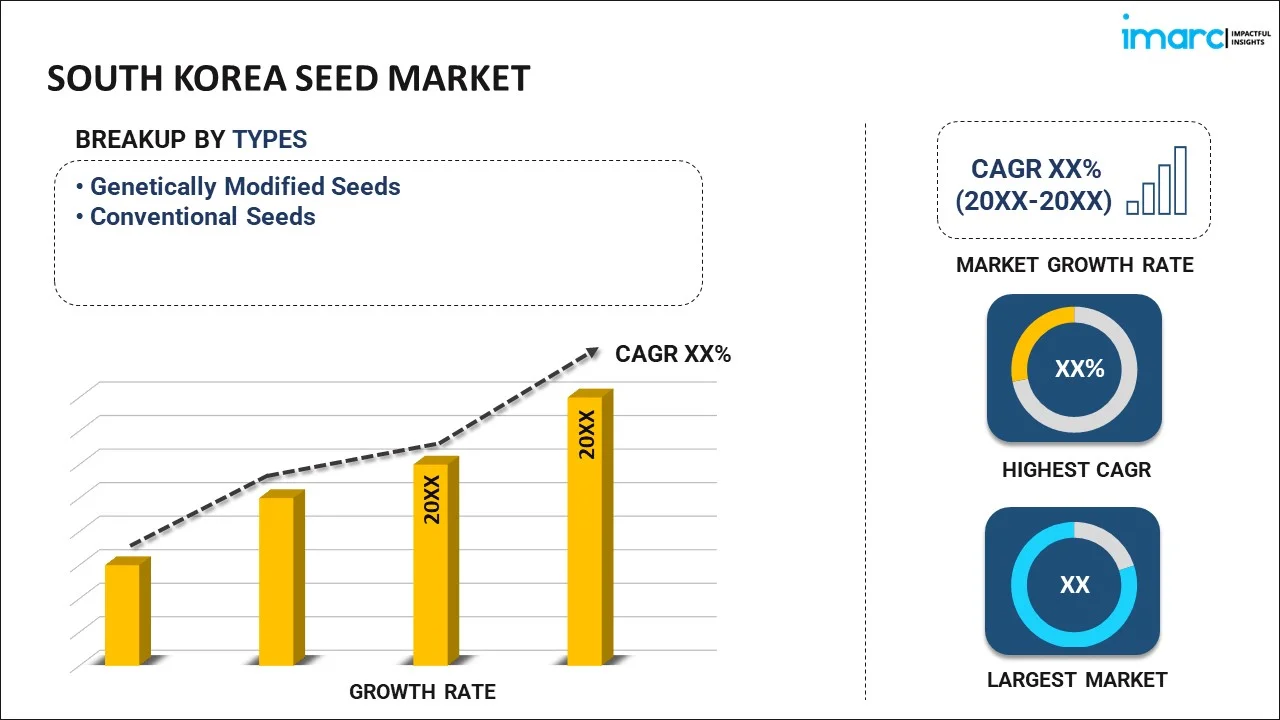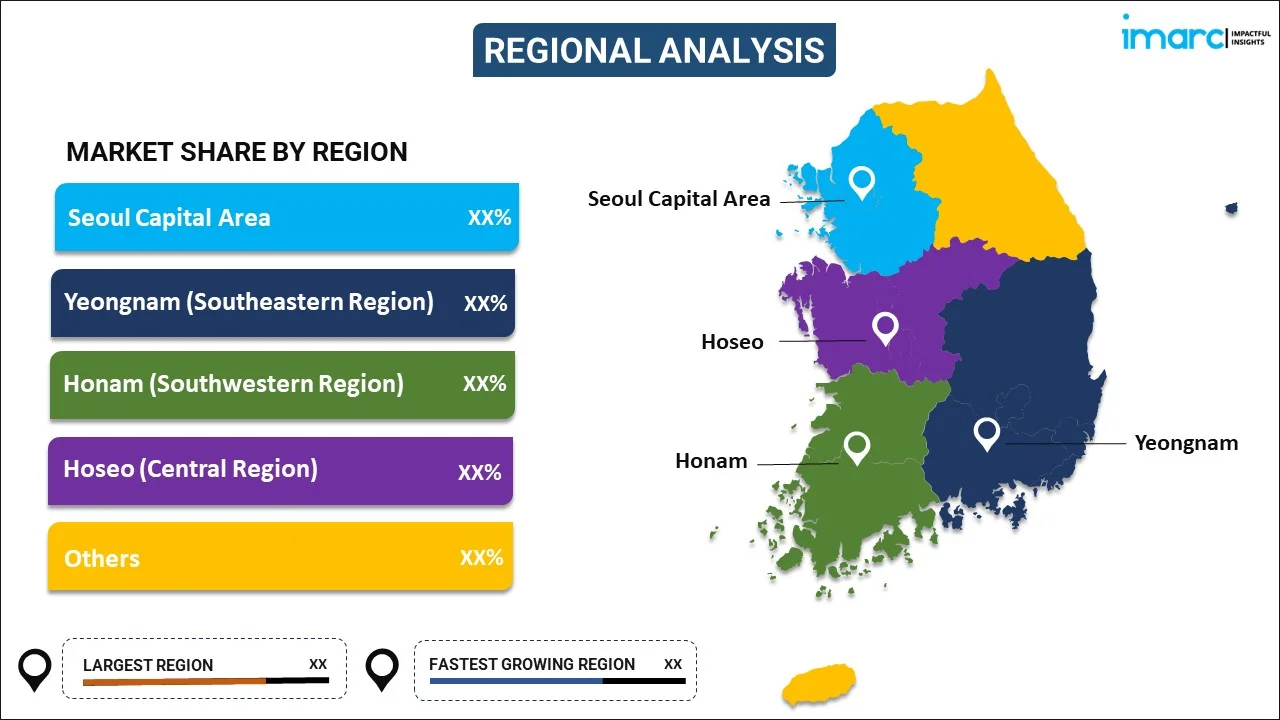
South Korea Seed Market Report by Type (Genetically Modified Seeds, Conventional Seeds), Seed Type (Oilseeds, Cereals and Grains, Fruits and Vegetables, Burpee and Park, and Others), Traits (Herbicide-Tolerant (HT), Insecticide-Resistant (IR), and Others), Availability (Commercial Seeds, Saved Seeds), Seed Treatment (Treated, Untreated), and Region 2025-2033
Market Overview:
South Korea seed market size reached USD 1.6 Billion in 2024. Looking forward, IMARC Group expects the market to reach USD 2.7 Billion by 2033, exhibiting a growth rate (CAGR) of 5.95% during 2025-2033. The growing usage of environmentally friendly practices aligns with the trend towards organic and non-GMO seeds, which is primarily driving the market growth across the country.
|
Report Attribute
|
Key Statistics
|
|---|---|
|
Base Year
|
2024 |
|
Forecast Years
|
2025-2033 |
|
Historical Years
|
2019-2024
|
| Market Size in 2024 | USD 1.6 Billion |
| Market Forecast in 2033 | USD 2.7 Billion |
| Market Growth Rate (2025-2033) | 5.95% |
Seed are nascent plant entities embodying the capacity for future expansion and maturation. Originating within the reproductive organs of flowering plants (angiosperms) and non-flowering plants (gymnosperms), they harbor the potential to sprout under favorable conditions such as adequate moisture, optimal temperature, and the presence of oxygen. Essential for maintaining genetic diversity within plant species, seeds ensure resilience in the face of evolving environments and adversities. In agriculture, they serve as fundamental elements for cultivating crops destined for food, fodder, and industrial applications. Additionally, seeds play a crucial role in nurturing ornamental plants, flowers, and greenery for landscaping purposes in diverse settings like gardens, parks, and urban areas.
South Korea Seed Market Trends:
The seed market in South Korea is propelled by a combination of agricultural innovation, technological advancements, and a growing emphasis on sustainable practices. With a focus on ensuring food security and enhancing crop productivity, the demand for high-quality seeds is on the rise. Additionally, the adoption of advanced agricultural techniques, including precision farming and smart agriculture, has driven the need for genetically improved and disease-resistant seeds. Besides this, government initiatives supporting modernization in agriculture and a push towards self-sufficiency contribute to the growth of the seed market. As consumers become more conscious of the origin and quality of their food, there is an increasing demand for seeds that align with sustainable and health-conscious farming practices. Moreover, technological trends, such as the use of biotechnology in seed development, play a significant role. Genetically modified (GM) seeds that offer improved traits, such as resistance to pests and diseases or enhanced nutritional content, are gaining traction. Additionally, the integration of digital technologies in agriculture, such as data-driven decision-making and precision agriculture, is influencing the seed market. Apart from this, the ornamental and landscaping sectors also contribute to seed market dynamics in South Korea. The desire for aesthetically pleasing outdoor spaces has led to an increased demand for a variety of flower and ornamental plant seeds. This, in turn, is expected to fuel the market growth over the forecasted period.
South Korea Seed Market Segmentation:
IMARC Group provides an analysis of the key trends in each segment of the market, along with forecasts at the country level for 2025-2033. Our report has categorized the market based on type, seed type, traits, availability, and seed treatment.
Type Insights:

- Genetically Modified Seeds
- Conventional Seeds
The report has provided a detailed breakup and analysis of the market based on the type. This includes genetically modified seeds and conventional seeds.
Seed Type Insights:
- Oilseeds
- Soybean
- Sunflower
- Cotton
- Canola/Rapeseed
- Cereals and Grains
- Corn
- Wheat
- Rice
- Sorghum
- Fruits and Vegetables
- Tomatoes
- Lemons
- Brassica
- Pepper
- Lettuce
- Onion
- Carrot
- Burpee and Park
- Others
A detailed breakup and analysis of the market based on the seed type have also been provided in the report. This includes oilseeds (soybean, sunflower, cotton, and canola/rapeseed), cereals and grains (corn, wheat, rice, and sorghum), fruits and vegetables (tomatoes, lemons, brassica, pepper, lettuce, onion, and carrot), burpee and park, and others.
Traits Insights:
- Herbicide-Tolerant (HT)
- Insecticide-Resistant (IR)
- Others
The report has provided a detailed breakup and analysis of the market based on the traits. This includes herbicide-tolerant (HT), insecticide-resistant (IR), and others.
Availability Insights:
- Commercial Seeds
- Saved Seeds
A detailed breakup and analysis of the market based on the availability have also been provided in the report. This includes commercial seeds and saved seeds.
Seed Treatment Insights:
- Treated
- Untreated
The report has provided a detailed breakup and analysis of the market based on the seed treatment. This includes treated and untreated.
Regional Insights:

- Seoul Capital Area
- Yeongnam (Southeastern Region)
- Honam (Southwestern Region)
- Hoseo (Central Region)
- Others
The report has also provided a comprehensive analysis of all the major regional markets, which include Seoul Capital Area, Yeongnam (Southeastern Region), Honam (Southwestern Region), Hoseo (Central Region), and Others.
Competitive Landscape:
The market research report has also provided a comprehensive analysis of the competitive landscape in the market. Competitive analysis such as market structure, key player positioning, top winning strategies, competitive dashboard, and company evaluation quadrant has been covered in the report. Also, detailed profiles of all major companies have been provided.
South Korea Seed Market Report Coverage:
| Report Features | Details |
|---|---|
| Base Year of the Analysis | 2024 |
| Historical Period | 2019-2024 |
| Forecast Period | 2025-2033 |
| Units | Billion USD |
| Scope of the Report | Exploration of Historical and Forecast Trends, Industry Catalysts and Challenges, Segment-Wise Historical and Predictive Market Assessment:
|
| Types Covered | Genetically Modified Seeds, Conventional Seeds |
| Seed Types Covered |
|
| Traits Covered | Herbicide-Tolerant (HT), Insecticide-Resistant (IR), Others |
| Availabilities Covered | Commercial Seeds, Saved Seeds |
| Seed Treatments Covered | Treated, Untreated |
| Regions Covered | Seoul Capital Area, Yeongnam (Southeastern Region), Honam (Southwestern Region), Hoseo (Central Region), Others |
| Customization Scope | 10% Free Customization |
| Post-Sale Analyst Support | 10-12 Weeks |
| Delivery Format | PDF and Excel through Email (We can also provide the editable version of the report in PPT/Word format on special request) |
Key Questions Answered in This Report:
- How has the South Korea seed market performed so far and how will it perform in the coming years?
- What has been the impact of COVID-19 on the South Korea seed market?
- What is the breakup of the South Korea seed market on the basis of type?
- What is the breakup of the South Korea seed market on the basis of seed type?
- What is the breakup of the South Korea seed market on the basis of traits?
- What is the breakup of the South Korea seed market on the basis of availability?
- What is the breakup of the South Korea seed market on the basis of seed treatment?
- What are the various stages in the value chain of the South Korea seed market?
- What are the key driving factors and challenges in the South Korea seed?
- What is the structure of the South Korea seed market and who are the key players?
- What is the degree of competition in the South Korea seed market?
Key Benefits for Stakeholders:
- IMARC’s industry report offers a comprehensive quantitative analysis of various market segments, historical and current market trends, market forecasts, and dynamics of the South Korea seed market from 2019-2033.
- The research report provides the latest information on the market drivers, challenges, and opportunities in the South Korea seed market.
- Porter's five forces analysis assist stakeholders in assessing the impact of new entrants, competitive rivalry, supplier power, buyer power, and the threat of substitution. It helps stakeholders to analyze the level of competition within the South Korea seed industry and its attractiveness.
- Competitive landscape allows stakeholders to understand their competitive environment and provides an insight into the current positions of key players in the market.
Need more help?
- Speak to our experienced analysts for insights on the current market scenarios.
- Include additional segments and countries to customize the report as per your requirement.
- Gain an unparalleled competitive advantage in your domain by understanding how to utilize the report and positively impacting your operations and revenue.
- For further assistance, please connect with our analysts.
 Request Customization
Request Customization
 Speak to an Analyst
Speak to an Analyst
 Request Brochure
Request Brochure
 Inquire Before Buying
Inquire Before Buying




.webp)




.webp)












